AMD Kaveri Review: A8-7600 and A10-7850K Tested
by Ian Cutress & Rahul Garg on January 14, 2014 8:00 AM ESTIntegrated GPU Performance: Sleeping Dogs
Sleeping Dogs is a benchmarking wet dream – a highly complex benchmark that can bring the toughest setup and high resolutions down into single figures. Having an extreme SSAO setting can do that, but at the right settings Sleeping Dogs is highly playable and enjoyable. We run the basic benchmark program laid out in the Adrenaline benchmark tool, and their three default settings of Performance (1280x1024, Low), Quality (1680x1050, Medium/High) and Xtreme (1920x1080, Maximum) noting down the average frame rates and the minimum frame rates.
Sleeping Dogs, Performance Settings
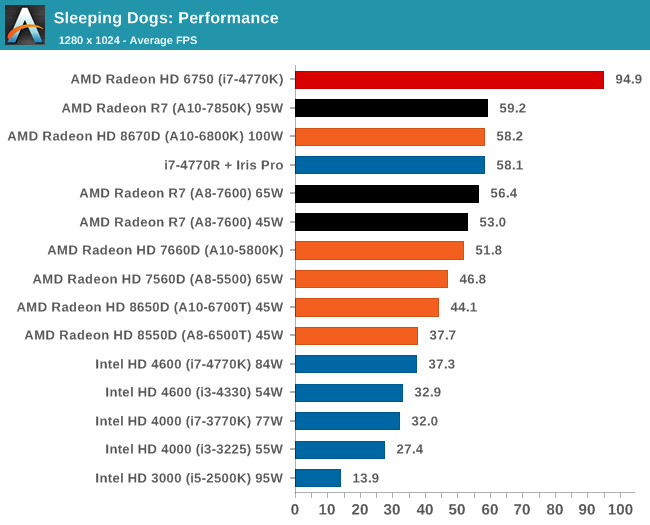
All the AMD APUs tested for this review manage to go above 30 FPS for Sleeping Dogs, with the top end APU nudging at the door of 60 FPS average.
Sleeping Dogs, Quality Settings
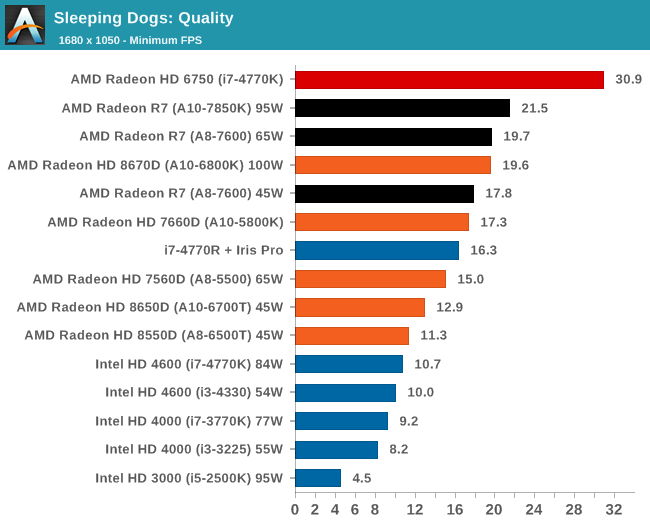
The GCN based Kaveri take the top two IGP spots, and Iris Pro is moving down the list by comparison.
Sleeping Dogs, Xtreme Settings

Iris Pro struggles a lot at 1080p in Sleeping Dogs.
Integrated GPU Performance: Company of Heroes 2
The final gaming benchmark is another humdinger. Company of Heroes 2 also can bring the house down, even at very basic benchmark settings. To get an average 30 FPS at any settings using integrated graphics is a challenge, let alone a minimum frame rate of 30 FPS. For this benchmark I use modified versions of Ryan’s batch files more suited for integrated graphics: 1280x1024 on minimum; 1680x1050 on Low and 1920x1080 on Medium.
Company of Heroes 2, Performance Settings
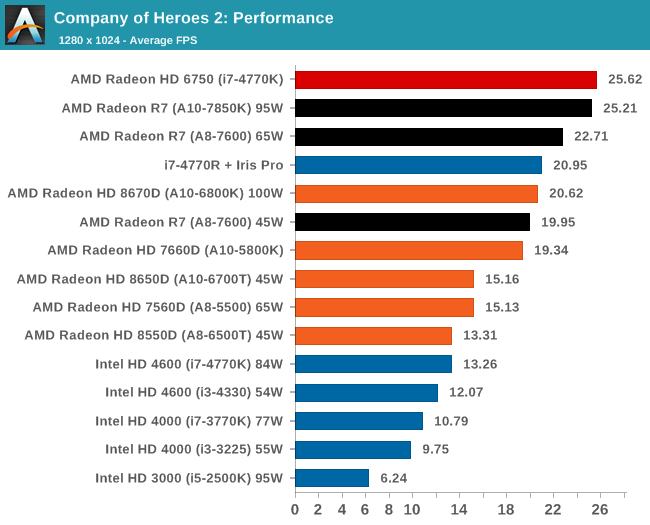
COH2 is demanding enough that even at 1280x1024 and low settings, no platform we tested today can hit 30 FPS average. The 95W Kaveri part does however outshine Richland by almost 25%.
Company of Heroes 2, Quality Settings
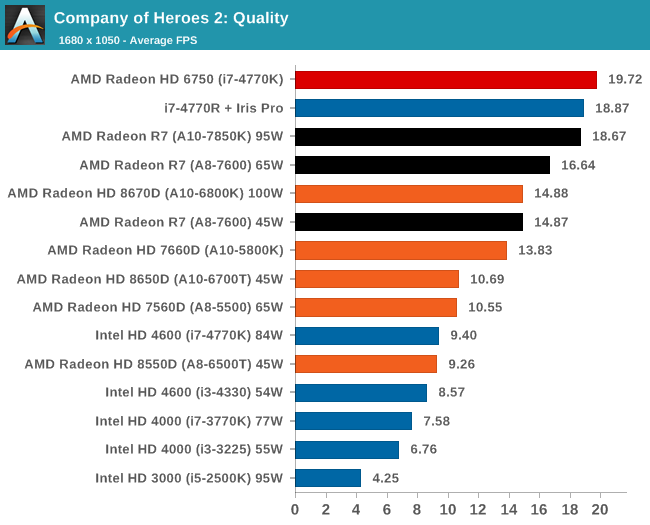
Company of Heroes 2, Xtreme Settings
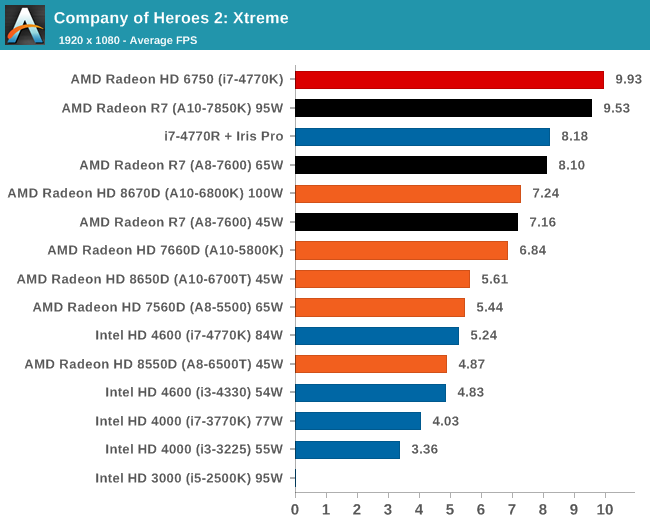
With COH2 extreme settings, the Intel solutions are moving up the minimum FPS ranks to beat AMD.










380 Comments
View All Comments
Ian Cutress - Tuesday, January 14, 2014 - link
I did a look back to C2D this time last year: http://www.anandtech.com/show/6670/dragging-core2d...When I get into the swing of testing for Gaming CPU viability again, I'll make sure it is part of the testing matrix.
ImSpartacus - Tuesday, January 14, 2014 - link
I've been reading Anadtech since I was in high school and that has to be my favorite article. I reference that article constantly.It's so hard to find reliable & exhaustive benchmarks of old CPUs. If you could update it every 2 years, I would love you forever!
just4U - Tuesday, January 14, 2014 - link
I read that article and it got me to thinking.. Maybe what is needed is not a direct comparison with new and competing products (which companies may not like..) but rather something stand alone that gets refreshed like your E6400 article. It sets the bar on what the reviewer (and likely most of us) think is needed these days..I know for myself I see a lot steps sideways in the computer industry but it's no longer leaps ahead like it once was.alyarb - Wednesday, January 15, 2014 - link
That would be great. I have a C2Q at 3.7 GHz and a 5850 at 800 MHz. Sure, that is >350W under load, but it still gets the job done at 1080p even in 2014. I have tried and can't justify replacing it all just yet.Similarly I'm not surprised to see Llano is not at the bottom of these charts and is still within striking distance of Kaveri in a lot of the tests. One day I'd like to see the past 8 or 10 years of CPUs all put through the same battery of 2013-2014 tests.
Integration and new features are all welcome, but let's take a look, as performance skeptics, at how far we've really come all this time.
anubis44 - Saturday, January 18, 2014 - link
"I have a C2Q at 3.7 GHz and a 5850 at 800 MHz. Sure, that is >350W under load, but it still gets the job done at 1080p even in 2014. I have tried and can't justify replacing it all just yet."Try playing Company of Heroes 2 (my current favourite) on that rig, and understand the meaning of the word 'obsolete'. That game will bring that system to it's knees, and it won't be pretty.
just4U - Sunday, January 19, 2014 - link
Throw in a 760 or a 280x then.. see if it's still brought to it's knees.. Hell a 270/x might do.. it's substantially faster than the 5850 as well.SofS - Friday, January 17, 2014 - link
Careful when comparing older processors regarding the memory subsystem since without the integrated controller they are very sensitive to memory performance or at least my C2Q 9550 @3410MHz seems to be. In my case the upgrade to to a G.Skill F3-12800CL6-2GBXH dual kit I made some years ago was meaningful and some other readers here on similar platforms might find that only upgrading the RAM would give them headroom enough to avoid a whole new system purchase for a while longer. Currently I also own a i7-4800MQ based notebook with dual KHX1600C9S3/8G and while noticeably faster for some cases it does not really enable me to game at higher settings than my desktop system given the GPU being a GTX 765M. Going forward a GPU upgrade to the desktop system is all I am looking for.RussianSensation - Friday, January 17, 2014 - link
Sorry, but you may have a confirmation bias here. You bought new memory expecting the system to perform much faster but years and years of personal ownership of C2D/C2Q systems and online reviews show that it hardly performed faster with faster memory. That architecture in fact performed faster with tighter latency. Your kit doesn't even have 5-5-5-15 timings. C2Q 9550 @ 3.4ghz is a slow CPU compared to Core i7 4770 @ 4.5ghz for gaming. Your memory upgrade may have netted you an extra 2-3% increase on average at best.SofS - Friday, January 17, 2014 - link
Come to think of it, maybe the amount was more important, besides going down to CL6 previously it was 2x1GB instead of 2x2GB. If that is the case then my 765M must be holding the 4800MQ back for gaming or something else is very wrong. Currently the only games I play that do not perform properly at 1080p are Witcher2 and Tomb Raider, probably that has more to do with the GPU than the CPU/RAM tough the real question is if a better next generation mid range GPU would still be able to work properly with them.Albangalo - Wednesday, January 15, 2014 - link
While it's not to do with Kaveri, Tom's Hardware did some articles comparing current cpus with older ones:Intel Ivy vs c2d & c2q: http://www.tomshardware.com/reviews/ivy-bridge-wol...
AMD fx vs k10: http://www.tomshardware.com/reviews/piledriver-k10...